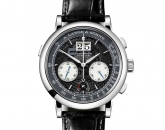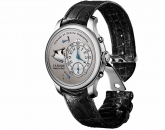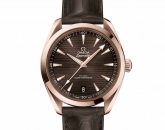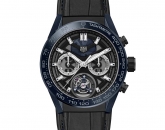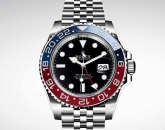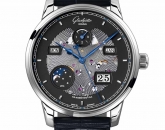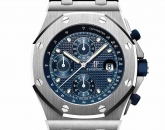Watchmakers are a very resilient breed. In spite of the challenges faced during the GFC – the suave, private-banker way to say global financial crisis – the industry has gotten up on its feet, brushed the dust off and started running. And the speed to which it has recovered is impressive. In fact, sales in 2010 were only five percent shy of the record CHF17 billion reached in 2008, and given the lower price points watches were at last year, the industry actually sold the most number of timepieces it has since 2002. This means, simply, that the efforts to go back to watchmaking's core values have paid off, and many more people like us have become happy watch owners because of it. In the last 12 months, the industry has moved forward to a point where the more established and institutional brands – plus a few large independents – are really pushing through in terms of expansion (points-of-sale and boutiques), vertical industrialization, and investments in research. Groups that cover the market consistently, from low, to the very high end, or offer diversity in their product range are gaining ground. The effect? There is essentially a smorgasbord of timepieces out there to satisfy your simplest or most exorbitant craving. Let’s talk about sports watches for instance. Looking for a watch to go with your McLaren MP4-12C? (Or at least make you feel like you have one?) Tag Heuer releases the Carrera MP4-12C Chronograph this year, a limited edition of 1,000 pieces, and featuring a carbon-based dial inspired by the supercar's chassis. Sapphire crystal inserts create an open-worked view of the movement, which comes with a semi-perpetual calendar function, big date, and flyback. The case is in lightweight titanium, with a black aluminium bezel. This ultra-tech soup-up for the wrist will cost you a competitive US$14,000. One of my favourites from the diver's watch offerings of 2011 is Jaeger-LeCoultre's Memovox Tribute to Deep Sea. The watch originally appeared in 1959, after explorer and filmmaker Jacques Yves-Cousteau's underwater film The Silent World debuted in Cannes and caused a renewed interest in diving. The new version is pretty much a carbon copy of the original, except for a slight increase in diameter, to 40.5mm. The watch even skips the use of sapphire crystal in favour of Plexiglas for a real retro look. The Memovox Tribute to Deep Sea is fitted with the automatic Caliber 815 with mechanical alarm function, and is priced at around US$12,000. Can we even talk about sports watches without mentioning Rolex? I reported on this piece briefly in my best of Basel countdown [April 2011 issue], but I have to say that in terms of look, function and material combination, the new Cosmograph Daytona, with its sleek black Cerachrom (ceramic) bezel is pure genius. PVD black hour markers on a rich chocolate dial: striking, elegant, and something we have not seen before in a Rolex, and I for one am enamoured. Aside from the black ceramic bezel the Daytona pretty much has the same features as the last version of the watch, fitted with the chronograph calibre 4130, and with a 40mm case. Even now, there’s a buzz about what fans expect the 2012 Daytona to look like, given this refreshing update. We’ll just have to wait and see, won’t we? For now, I’d get on the waiting list. The new Cosmograph Daytona will go for about US$30,000. And if we're talking about ultra high-end innovation, I would also give a prize to Audemars Piguet's Royal Oak Offshore Tourbillon Chronograph. The name doesn't really reveal all: the watch is an automatic, but when you look at the caseback, you won't see an oscillating weight. That's because the calibre 2897 has been constructed with a peripheral rotor in platinum and mounted by ball bearings, that shifts it weight around the outside of the movement, underneath the bezel. This watch, priced at US$248,000, allows a full view of its beautiful, extra shock-protected, column-wheel calibre from the back, and is stamped with its powerful octagonal forged carbon bezel in front.
SMALL WORLD, BIG MARKET
One of the most obvious goals for watchmakers this year is to tap the biggest potential markets first, and on top of that list is China. The watch bosses I spoke with at BaselWorld all attest to the fact that this region is the best place to be in, for the next couple of years at least. One even showed me a graph of the orders and sales in their mainland boutiques, pointing out the glaring peaks, which if I remember correctly, revealed growth of more than 50 percent. So it's no surprise that we will continue to see a lot of designs that are geared toward Asia, and with business travellers in mind. I think this is one of the reasons that led to the release of so many world time watches this year. At Basel, Breguet presented the Classique Hora Mundi, a watch with an instant jump time-zone display and memory, featuring a synchronised date, day/night indication and city. Simply, it means that at a push of a button, the timepiece will be able to show the home time and date of a pre-selected time zone, without the clutter. For those who often travel to countries like India, where there are half-hour differences across regions, keeping track of time on a 24-hour system can be difficult. That is why Vacheron Constantin's Patrimony World Time has been created with 37 zones in total, taking half and even quarter-hour differences into consideration, and practically able to display all the known zones on earth. A Lambert projection map of the earth in miniature painting is the focal point of dial, made even more interesting by the half-tinted sapphire disc that rotates to give you the exact image of day and night across the continents. Another extraordinary take on the world time watch is the Calibre de Cartier Multifuseaux. The watch features two retrograde indicators on the dial. The first shows the 'home' time, and whether its day or night, and the second is a 'jet lag indicator,' which sits at zero when you're home, but adjusts to show the exact offset in hours between the local time and your 'home' time when travelling. Apart from these, the watch has been constructed with a sapphire window on the side of the case that has the names of the cities in each of the 24 time zones engraved. It sounds a bit complicated, but is in fact quite easy to read once you learn how to work the controls. And the unique look of the watch really makes it worth the trouble.
Nothing says travel more than IWC's Portofino Dual Time watch, a new addition to its popular series inspired by the beautiful Italian port favoured by celebrities. Powered by the new 64710 calibre, the watch features two sub dials, the top with a 24-hour display to show home time, and the bottom, small hacking seconds. The watch comes in a smoother, more contoured case in 18k red gold or stainless steel, with an option for either a Milanese mesh bracelet, or hand-dyed leather strap by famous Italian shoemaker Santoni. So have you decided yet? Whether your pick this year is a functional sports watch, a world time art piece, or an ultimate tech gadget, the massive selection out there proves one thing: that against all odds, capturing time and its fleeting nature will continue to be a fascination. And because of this, GFC or not, the watchmaking industry, as long as it’s armed with creativity and innovation, will always emerge victorious.
Click here to see the published article.








